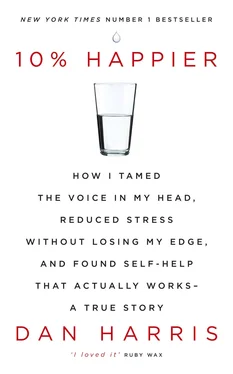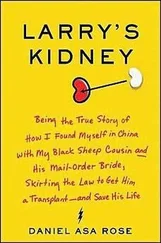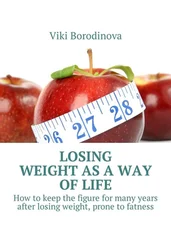I was also sensing new openness to meditation from another unexpected source: the woman who, for me, represented the gold standard in professional diligence, Diane Sawyer. She was one of the most fiercely intelligent and insatiably curious human beings I’d ever met. She read every newspaper and magazine known to man. She wrote and rewrote her own stories right up until airtime. She studied for interviews or major news events for weeks, memorizing obscure yet illuminating details.
Diane was inspiring to me in many of the same ways that Peter Jennings had been. She had a deep sense of responsibility to the audience. She insisted on providing viewers with useful information and practical insights rather than just doing the same old lazy story that everybody else was doing. She had a dizzying knack for identifying the key question at the heart of every story. Unlike with Peter, though, there were no temper tantrums. I had built up a reservoir of affection for Diane ever since she visited the ABC News bureau in Baghdad when I was stationed there before the war. Shortly after anchoring GMA live from the roof of the Information Ministry, she came to our office and spent several hours just hanging out. Here was a woman who had worked in the White House, become the first female correspondent for 60 Minutes , and had more journalism awards than I have teeth, casually eating bad Iraqi pizza with us.
That’s not to say I didn’t find her a little bit intimidating. When we went over scripts, she inevitably asked me an unanticipated and incisive question for which I had no answer.
At first, my meditation habit was a source of gentle ribbing. Diane had long teased me for being “pure.” She joked about my healthful diet, frequent exercise, and abstinence from booze and caffeine. (I had recently quit both—not because I had become a straight-edge yogi or whatever, but because, as I got older, my body simply couldn’t tolerate them.) I would try to defend myself, pointing to my dessert habit and taste for cheeseburgers. I did not, however, have the nerve to tell her I used to do enough drugs that it apparently contributed to my having a panic attack not ten yards away from her.
I fought through the fear that pitching Diane a story on meditation would only provoke an eye roll. I sent her an email, suggesting we do a piece about how the scientific research was inspiring people in unusual places to embrace mindfulness. To my delight, she bit.
When the PR woman in the leopard-print blouse started dropping phrases like “letting go,” and “turning in to your emotions,” I really knew meditation was breaking out of the Buddhist ghetto.
After Diane gave me the green light to go do some mindfulness stories, my first stop was Minneapolis, and the headquarters of General Mills, the corporate behemoth behind such brands as Cheerios, Betty Crocker, and Hamburger Helper. Everyone here was so earnest and hail-fellow-well-met, with crisp demeanors and twangy Midwest accents. Which made it all the more remarkable that there were now meditation rooms, complete with zafus and yoga mats, in every building in the complex.
The person responsible for this was a hard-charging, no-nonsense, sensible-haircut corporate attorney named Janice Marturano. She’d discovered meditation a few years prior, found it to be a massive value-add, both personally and professionally, and started spreading it virally through the executive ranks. She’d trained scores of her colleagues, including the PR woman whose job it was to shepherd us briskly through this hive of corporate busyness all day long.
A big part of Marturano’s success in bringing mindfulness to this unlikely venue was that she talked about it not as a “spiritual” exercise but instead as something that made you a “better leader” and “more focused,” and that enhanced your “creativity and innovation.” She didn’t even like the term “stress reduction.” “For a lot of us,” she said, “we think that having stress in our lives isn’t a bad thing. It gives us an edge.” I liked this—a meditation philosophy that left room for the “price of security.”
Marturano had a whole slew of practical tips that extended well beyond the meditation cushion. One of her main pieces of advice was a direct challenge to me, an assault on a central pillar of my work life.
“So you’re telling me that I can’t multitask?” I asked as we sat down for an interview.
“It’s not me telling you,” she said. “It’s neuroscience that would say that our capacity to multitask is virtually nonexistent. Multitasking is a computer-derived term. We have one processor. We can’t do it.”
“I think that when I’m sitting at my desk feverishly doing seventeen things at once that I’m being clever and efficient, but you’re saying I’m actually wasting my time?”
“Yes, because when you’re moving from this project to this project, your mind flits back to the original project, and it can’t pick it up where it left off. So it has to take a few steps back and then ramp up again, and that’s where the productivity loss is.” This problem was, of course, exacerbated in the age of what had been dubbed the “infoblitzkrieg,” where it took superhuman strength to ignore the siren call of the latest tweet, or the blinking red light on the BlackBerry. Scientists had even come up with a term for this condition: “continuous partial attention.” It was a syndrome with which I was intimately familiar, even after all my meditating.
Marturano recommended something radical: do only one thing at a time. When you’re on the phone, be on the phone. When you’re in a meeting, be there. Set aside an hour to check your email, and then shut off your computer monitor and focus on the task at hand.
Another tip: take short mindfulness breaks throughout the day. She called them “purposeful pauses.” So, for example, instead of fidgeting or tapping your fingers while your computer boots up, try to watch your breath for a few minutes. When driving, turn off the radio and feel your hands on the wheel. Or when walking between meetings, leave your phone in your pocket and just notice the sensations of your legs moving.
“If I’m a corporate samurai,” I said, “I’d be a little worried about taking all these pauses that you recommend because I’d be thinking, ‘Well, my rivals aren’t pausing. They’re working all the time.’ ”
“Yeah, but that assumes that those pauses aren’t helping you. Those pauses are the ways to make you a more clear thinker and for you to be more focused on what’s important.”
This was another attack on my work style. I had long assumed that ceaseless planning was the recipe for effectiveness, but Marturano’s point was that too much mental churning was counterproductive. When you lurch from one thing to the next, constantly scheming, or reacting to incoming fire, the mind gets exhausted. You get sloppy and make bad decisions. I could see how the counterintuitive act of stopping, even for a few seconds, could be a source of strength, not weakness. This was a practical complement to Joseph’s “is this useful?” mantra. It was the opposite of zoning out, it was zoning in.
In fact, I looked into it and found there was science to suggest that pausing could be a key ingredient in creativity and innovation. Studies showed that the best way to engineer an epiphany was to work hard, focus, research, and think about a problem—and then let go. Do something else. That didn’t necessarily mean meditate, but do something that relaxes and distracts you; let your unconscious mind go to work, making connections from disparate parts of the brain. This, too, was massively counterintuitive for me. My impulse when presented with a thorny problem was to bulldoze my way through it, to swarm it with thought. But the best solutions often come when you allow yourself to get comfortable with ambiguity. This is why people have aha moments in the shower. It was why Kabat-Zinn had a vision while on retreat. It was why Don Draper from Mad Men , when asked how he comes up with his great slogans, said he spends all day thinking and then goes to the movies.
Читать дальше












